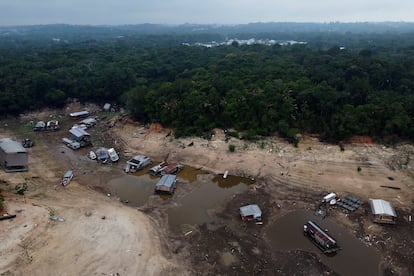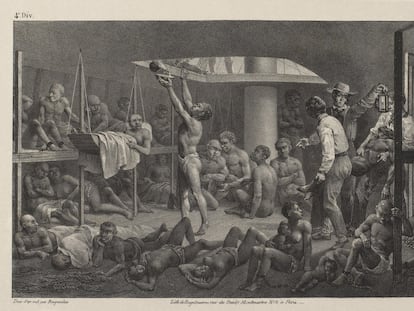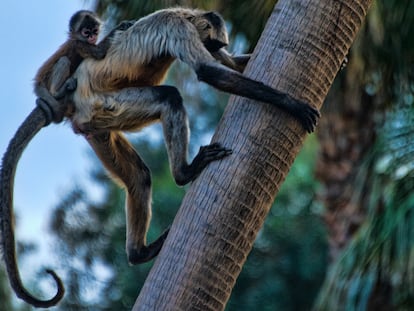In Brazil’s Amazon, rivers fall to record low levels during drought
Monday’s record confirms that this part of the world’s largest rainforest is suffering its worst drought, just a little over two years after its most significant flooding

The Negro River, the Amazon’s second largest tributary, on Monday reached its lowest level since official measurements began near Manaus 121 years ago. The record confirms that this part of the world´s largest rainforest is suffering its worst drought, just a little over two years after its most significant flooding.
In the morning, the water level in the city´s port went as low as 13.5 meters (44.3 feet), down from 30.02 meters (98.5 feet) registered in June 2021 — its highest level on record. The Negro River drains about 10% of the Amazon basin and is the world’s sixth largest by water volume.
Madeira River, another main tributary of the Amazon, has also recorded historically low levels, causing the halt of the Santo Antonio hydroelectric dam, Brazil´s fourth largest.
Throughout Brazil´s Amazon, low river levels have left hundreds of riverine communities isolated and struggling to get access to drinkable water. The drought also has disrupted commercial navigation that supplies Manaus, a city of 2 million with a large industrial park.
Manaus is the largest city and capital of Amazonas, the state hit hardest by the drought. In late September, 55 of 62 municipalities there entered states of emergency due to the severe drought.
“There is no more water to go through. Navigation is over,” boatman Cledson Lopes Brasil told The Associated Press.
Brasil operates in Marina do Davi port, a getaway to dozens of riverine communities, some of them with sandy beaches that attract tourists. The once bustling area is now surrounded by parched soil, with many boathouses high and dry.
For one month now, Brasil has switched to a lower-powered boat, better suited for shallow waters. Still, he can´t reach most communities along Taruma-Açu, a tributary of the Negro River. Some riverine dwellers must walk up to three hours to reach their houses — and tourism has stopped altogether.
Manaus and other nearby cities are also suffering from high temperatures and heavy smoke from nearby man-caused fires for deforestation and pasture clearance. The drought is also the likely cause of dozens of river dolphin deaths in Tefe Lake, near the Amazon River.
This is a startling contrast to July 2021, when Negro River waters took over part of the Manaus downtown area. The historic flood, which also ruined crops of hundreds of riverine communities, lasted for about three months.
Negro River ends near Manaus, where it converges with the Amazon River, which is called the Solimoes River in Brazil upstream from this confluence. In Brazilian maps, this marks the beginning of the Amazon, with Negro as the second main tributary. In international maps, however, the Amazon River begins in Peru.
Philip Fearnside, an American researcher at the Brazilian National Institute of Amazonian Research, a public agency, expects the situation to deteriorate, both during the ongoing event and in the future with increasing frequency and severity of similar events with climate change.
He said surface water in the eastern equatorial Pacific Ocean is now warmer than during the “Godzilla” El Niño of 2015-2016 and is expanding. In the Amazon, these Pacific warmings primarily lead to droughts in the northern part of the region.
Moreover, a warm water patch in the tropical North Atlantic Ocean is causing drought in the southern part of the Amazon, similar to what happened in 2005 and 2010, according to researchers.
“The forecast is for the start of the rains to be delayed compared to normal, and for a drier-than-normal rainy season,” Fearnside said. “This could result not only in extreme low water this year, but also low levels in 2024. Until the rainy season begins in the basin, the situation that is already underway should worsen.”
Sign up for our weekly newsletter to get more English-language news coverage from EL PAÍS USA Edition
Tu suscripción se está usando en otro dispositivo
¿Quieres añadir otro usuario a tu suscripción?
Si continúas leyendo en este dispositivo, no se podrá leer en el otro.
FlechaTu suscripción se está usando en otro dispositivo y solo puedes acceder a EL PAÍS desde un dispositivo a la vez.
Si quieres compartir tu cuenta, cambia tu suscripción a la modalidad Premium, así podrás añadir otro usuario. Cada uno accederá con su propia cuenta de email, lo que os permitirá personalizar vuestra experiencia en EL PAÍS.
¿Tienes una suscripción de empresa? Accede aquí para contratar más cuentas.
En el caso de no saber quién está usando tu cuenta, te recomendamos cambiar tu contraseña aquí.
Si decides continuar compartiendo tu cuenta, este mensaje se mostrará en tu dispositivo y en el de la otra persona que está usando tu cuenta de forma indefinida, afectando a tu experiencia de lectura. Puedes consultar aquí los términos y condiciones de la suscripción digital.
More information
Últimas noticias
ChatGPT fails the test: This is how it endangers the lives of minors
The late consecration of women artists in their 90s
The Florida Keys tourist paradise is besieged by immigration agents: ‘We’ve never seen anything like this’
The latest scam on WhatsApp behind the legal dream: using immigration status as bait
Most viewed
- Families demand repatriation of bodies of Colombians who died in Ukraine: ‘This war is a slaughterhouse for foreigners’
- The low-cost creative revolution: How technology is making art accessible to everyone
- Liset Menéndez de la Prida, neuroscientist: ‘It’s not normal to constantly seek pleasure; it’s important to be bored, to be calm’
- Christian Louboutin: ‘Young people don’t want to be like their parents. And if their parents wear sneakers, they’re going to look for something else’
- ‘El Limones’ and the growing union disguise of Mexican organized crime










































